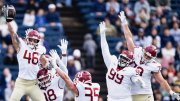In its early years, American football used a round ball that players would hold in their hands, drop to the ground, and kick on a low bounce. With the advent of the forward pass, the ball took on its current elliptical shape, making it easier to throw—but causing unpredictable bounces. So the drop kick gave way to placekicking, with tees (for kickoffs) and holders (for field goals and extra points).
For many decades, placekickers weren’t specialists: position players moonlighted at the task. Gino Cappelletti of the Boston (now New England) Patriots, for example, was a wide receiver, and the legendary Lou “the Toe” Groza of the Cleveland Browns was an offensive tackle. Groza converted 88.5 percent of his attempts in 1953, at a time when most National Football League (NFL) teams missed more than half their field goals.
In the 1960s, accuracy rose markedly with the advent of “soccer-style” kicking, which a Budapest-born Cornell graduate, Pete Gogolak, brought to American football. He kicked for the Buffalo Bills and then the New York Giants (becoming their all-time leading scorer) from 1964 until 1974.
One of Lou Groza’s kicking shoes resides in the Smithsonian, but no NFL rule requires that kickers wear a shoe at all. Rich Karlis, who kicked mostly for the Denver Broncos, was the last of the barefoot placekickers; he ended his career with the Vikings and Lions, retiring in 1990.









